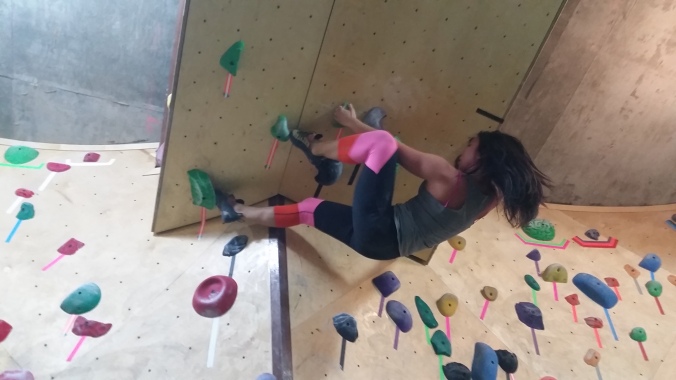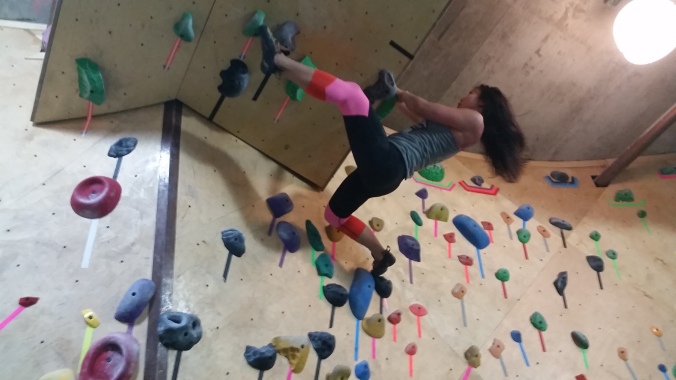Getting over overhangs might seem scary at first. After all, no one likes hanging upside down (unless you’re a bat), and falling off an overhanging roof while bouldering or on lead can be pretty precarious, and downright frightening. World-class climber Steph Davis once said,
“The hardest thing for new female climbers (especially those of us over age 12) is building upper body strength in proportion to overall strength/weight ratio.”
There’s a common misconception that climbing overhangs is all about upper body strength. Steph is definitely on point about overhanging climbs being more difficult for women due to our needing to build more strength/weight ratio, but the secret to rocking overhanging roofs is employing a total-body strategy:
- Avoid an arms-only strategy.Don’t campus it up, as tempting as it looks to pull your entire body weight up the entire wall. You will pump yourself out doing so.
- Keep your arms straight and feet up.Don’t let your feet fall behind your hands. If you’re too stretched out, you will swing away from the wall and you’ll have to pull hard to get back on it. You want your knees bent most of the time.
- Pivot like a Pro.Continually twist and turn your body, keeping your hips close by twisting one knee inwards to maximize reach. This allows you to make tough moves with the lowest amount of effort.
- Keep your core tight.You can’t expect your hands to hold your entire body weight for an extended period of time. You need your feet to hold as much of your weight as possible. To do this you need to tense your core. This requires core strength(stomach/back), which may take some time to build.
- Focus on your footwork.Keep your foot stance close to your body.If you move your upper body and arms, make sure you are moving your feet close to your torso, or your feet will fall off the rock/wall, and you will be doing a lot of hanging on your hands. Instead of having to pull up, keep as much weight on your feet as possible.
- Drop knees, not bombs.One of the hardest things about climbing overhanging routes is shifting the weight from the hands and arms to your core and feet. On overhangs, one of the best ways to accomplish this is the drop-knee. One of the reasons that the drop-knee works so well is that it allows you to stem in a short distance and it thrusts your torso in to the wall.
- Get hippy with it.Keep your hip from hanging out too far by getting your feet high and pulling/pushing your way over, since your legs are stronger than your fingers and arms. This will help ensure that your body weight is distributed towards your feet as much as possible. Also, try twisting your hips towards the rock/wall (see above point, Pivot Like a Pro) rather than maintaining your hips square. This will maximize your efficiency and reach while minimizing effort to allow you to power through moves while keeping your hips close on steep ground.
- Practice awareness.Always be aware of your center of gravity and keep your hips close to the wall. Being aware of your body position, visualizing the moves, and focusing on making smooth transitions from one position to the next will help you flow through the route.
And last, but certainly not least:
Rest > Strength
Learning to rest is the key to sending. Good roof climbers have strength and endurance, yes, but what they’re best at is managing and fighting off pump. They know how to reach a rest and then use it to recover strength and restart the pump clock. Practice resting as much as you practice climbing.

